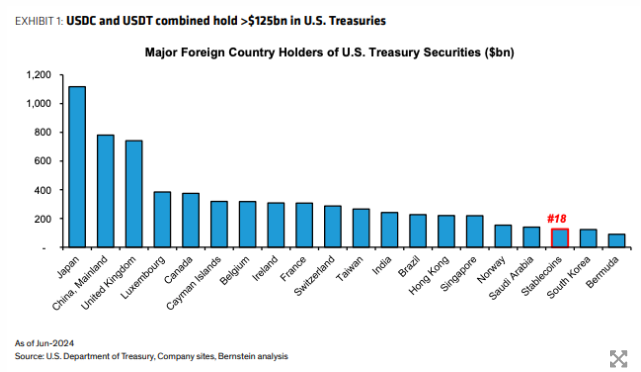Research and brokerage firm Bernstein said stablecoins are becoming "systemically important" and issuers are now the largest holders of U.S. Treasuries along with sovereign nations. After peaking in April 2022, the circulating supply of stablecoins has now returned to a historical high of approximately $180 billion.
Table of Contents
ToggleTether and Circle rank 18th among sovereign countries in holding U.S. debt
According to The Block , analysts at Bernstein said that blockchain-based stablecoins pegged to fiat currencies such as the U.S. dollar are reaching the level of systemic importance.
The U.S. debt held by stablecoin issuers Tether and Circle ranks 18th among sovereign countries, second only to Saudi Arabia and ahead of South Korea.

As the issuer retains the high yields from U.S. Treasury bonds, the stablecoin business remains highly profitable, with Tether achieving a net profit of US$5.2 billion in the first half of 2024.
Stablecoins have become “killer currencies”
Bernstein analysts pointed out that in the past 12 months, the monthly payment volume of on-chain stablecoins has tripled to $1.4 trillion, and stablecoins account for approximately 50% of all on-chain transaction volumes.
Monthly active users hit a new high of about 22 million, and the total number of non-zero balance stablecoin wallets now reaches 120 million. And the use of stablecoins has been decoupled from cryptocurrencies, with stablecoins increasingly being used for non-cryptocurrency use cases.
A previous stablecoin research report issued by Visa also showed that stablecoins have become the “killer currency” in cryptocurrencies, especially in emerging markets.
Stablecoin supply hits record high
According to The Block's data dashboard, the circulating supply of stablecoins peaked in 2022 and then declined with the bear market. The current supply of stablecoins in circulation has returned to an all-time high of nearly $180 billion.
Tether's USDT remains the dominant stablecoin, with a market capitalization of approximately $120 billion, followed by Circle's UDSC, with a market capitalization of approximately $35 billion.

New entrants continue to appear in the stablecoin market. PYUSD, jointly issued by PayPal and Paxos, currently has a circulating volume of close to approximately US$1 billion. Ripple recently announced plans to issue a new stablecoin for cross-border payments. After obtaining a British banking license in July, financial technology company Revolut also said it would enter the stablecoin market in the near future.
Other drivers of stablecoin growth include providing international users with access to U.S. dollar savings, access to digital dollars outside the U.S., serving as the primary base currency for cryptocurrency trading and enabling users to earn on DeFi platforms, and providing the cheapest cross-border Payment abroad.
Non-crypto uses for stablecoins are growing
Bernstein analysts said that non-crypto uses of stablecoins are growing, with currency exchange, payment for goods or services, and cross-border transactions being the most popular uses.
According to its survey, young people under the age of 35 hold an increasing proportion of stablecoins in their assets. Among respondents aged 18 to 24 in emerging markets, 35% own 25% of their assets in stablecoins. coins, while the proportion for the 45-54 age group is 17%.
Analysts believe that the opportunity for higher returns is the most common reason why younger generations choose stablecoins over U.S. dollar bank accounts. Another reason is that stablecoins bring them more trust, more stable value, and fewer opportunities. Government intervention.







